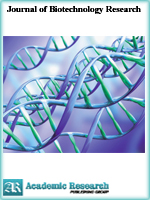Journal of Biotechnology Research
Online ISSN: 2413-3256
Print ISSN: 2413-8878
Print ISSN: 2413-8878
Quarterly Published (4 Issues Per Year)

Archives
Volume 8 Number 4 October 2022
OsAAP3 Gene Mutation Promotes the Chalkiness Character in Rice
Authors: Bo Peng ; Yan Liu ; Shuang Tu, et. al.
Pages: 46-53
DOI: doi.org/10.32861/jbr.84.46.53
Abstract
Rice chalkiness is one of the most important appearance quality traits and has a great impact on its processing quality, nutritional quality, cooking, and eating quality traits. It has important theoretical significance and application value to clarify the genetic mechanism of rice chalkiness. To reveal the relationship between chalkiness of OsAAP3 mutant rice and the shape, structure and arrangement of endosperm cells and starch grains, which will lay a foundation for further research on the formation mechanism of chalkiness character of rice and the cultivation of new high-quality rice varieties. The results showed that the chalkiness, chalkiness rate, and chalkiness area of OsAAP3 mutant rice significantly increased compared with the control ZH11, and there were significant variations in the arrangement, morphology, and cross-section starch grain distribution of the endosperm cells of the mutant rice: the white heart area of the mutant increased, and the white belly almost distributed in the edge of the whole rice cross-section. The chalky part and transparent part of the OsAAP3 mutant chalky rice also have obvious variations in the shape, structure, and arrangement of starch grains, but there is no significant difference between the transparent part of the mutant chalky rice and the starch grains of the non-chalky rice. The starch grains in the endosperm center of the OsAAP3 mutant of rice are well developed, but the starch grains in the abdomen and back are loosely arranged, and the starch grains are poorly developed. Therefore, the chalkiness character of OsAAP3 mutant rice increased significantly. The chalkiness character of its mutant mainly occurred in the abdomen, and the rest occurred in the center of the endosperm of rice. Moreover, the arrangement of starch grains in OsAAP3 mutant rice was loose, the grain shape was mostly irregular polyhedrons, and the starch development was poor.



